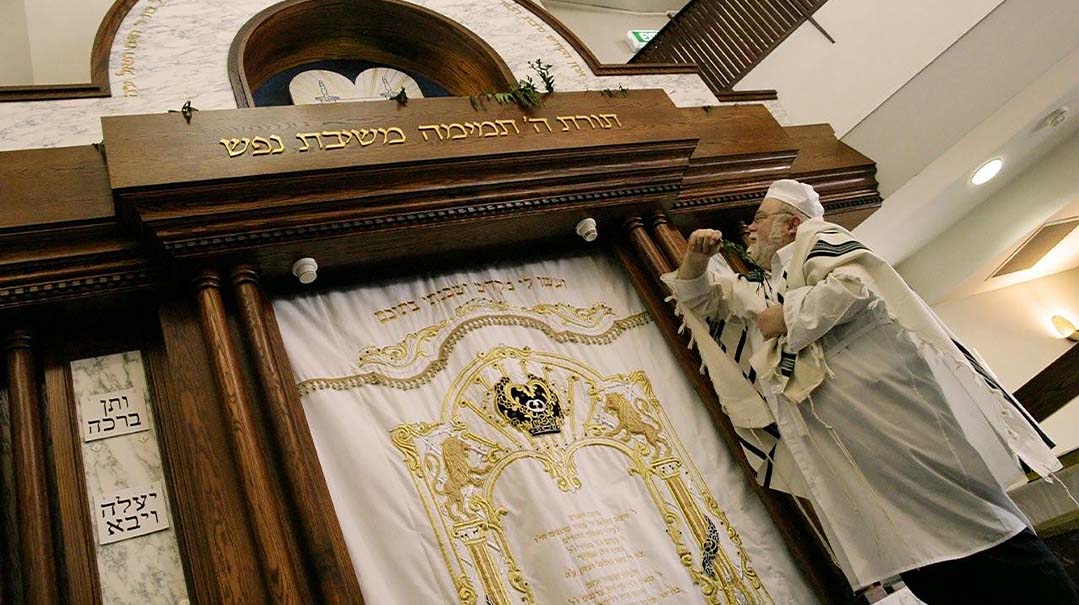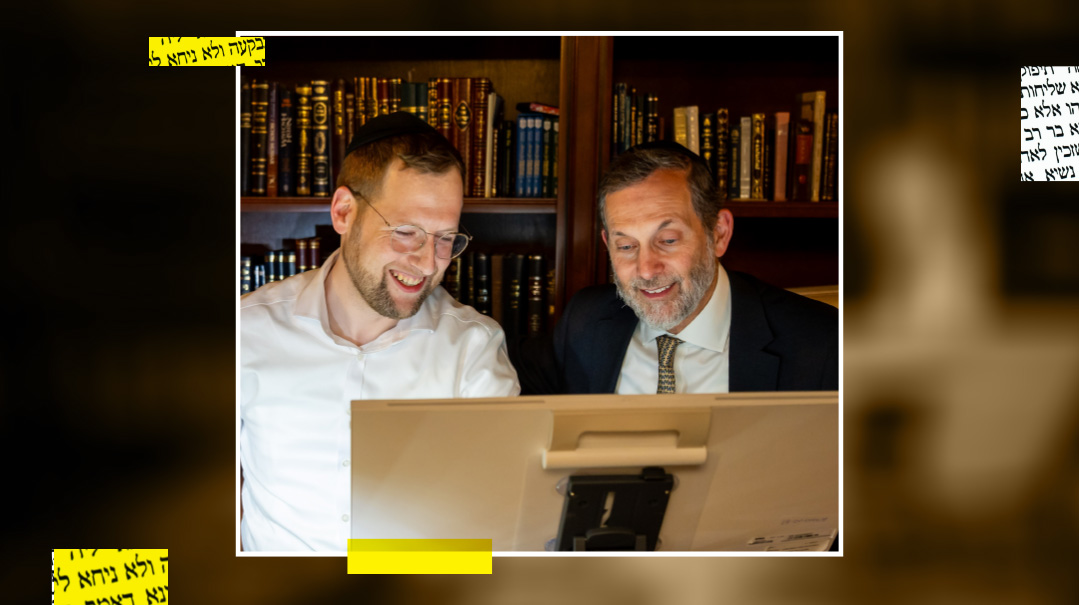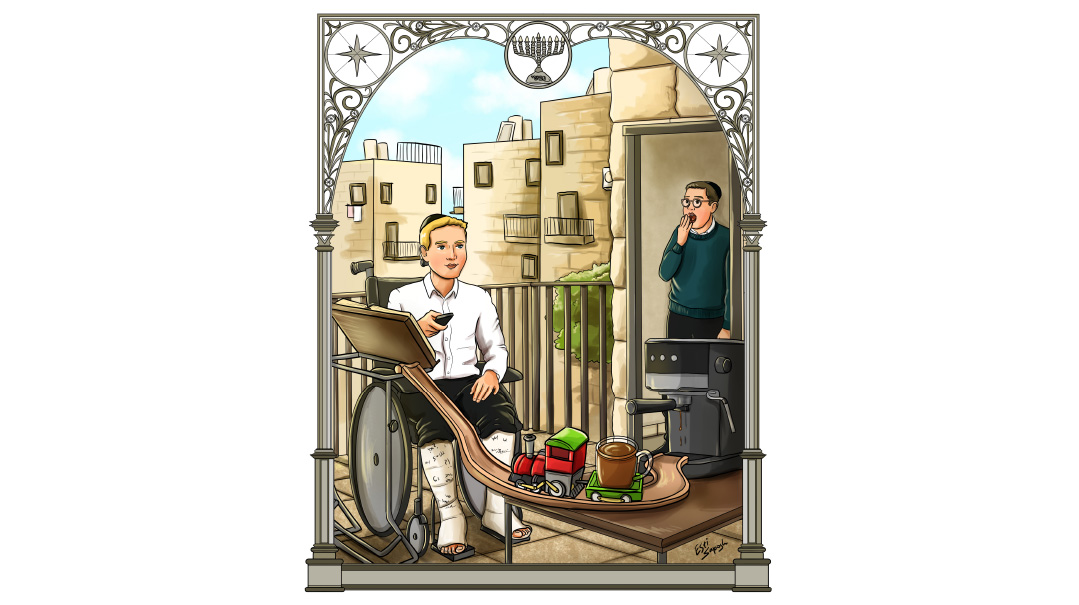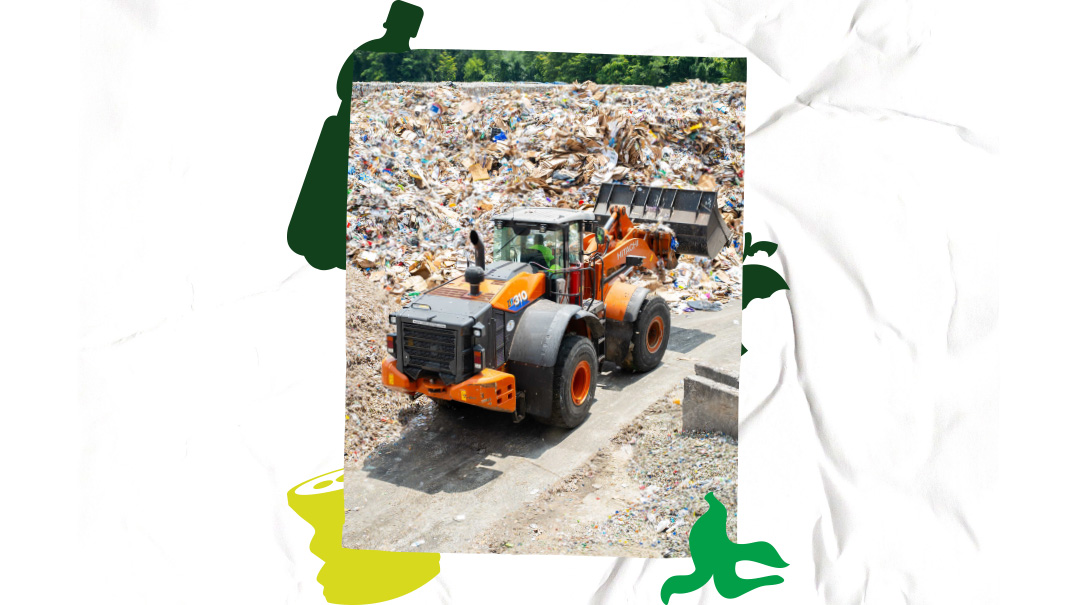We Won’t Let Go
| May 19, 2015We simply have a different, valid minhag

Your zeide was an Oberlander, tenaciously clinging to the old nusach and minhagim his family lived by for generations. But you live among 21st-century Yidden who are neatly grouped into categories of “chassid” or “Litvak.” Why hold on to those unfashionable customs, continuing to daven, dress, and act in the ancient style of a group whose ranks are shrinking?
If you’re an Oberlander, chassidim call you a Litvak and the litvish call you a chassid. But while the heimishe style of dress might look chassidish, an Oberlander Yid davens Nusach Ashkenaz and his minhagim bear a definite Ashkenaz stamp.
While the frum world tends to clump everyone into easily identifiable boxes, Oberlanders — Jews whose ancestors came to settle in the “highlands” [“Oberland”], or the northwestern part of Hungary, from neighboring Austria and Czechoslovakia (as opposed to the “lowlanders,” who later emigrated to the eastern territories from the borders of Galicia, Ukraine, and Romania) — bear their own distinct heritage, stubbornly clinging to the customs of their oft-misunderstood historic communities.
Your zeide lived in Nitra, in Unsdorf, in Paks, or in Szerdehel. He lived according to the mesorah of his fathers and grandfathers, the community following their rav in matters big and small, and the way forward was clear and uncompromising — there were no shortcuts yet no complications.
But you live in Yerushalayim, Boro Park, or London. On the corner is a chassidishe shtiebel, the next block yeshivah alumni. Your neighbors, lovely upright Yidden, are all serving the same G-d. So why hold on to the nusach and the minhagim that are so unfashionable today? Why continue to daven and dress in the style of a group that seems to be shrinking?
Reb Baruch Weissmandl is a scion of a prominent Oberlander family, a baal tefillah, and a staunch member of the Viener shul in Boro Park. He stands up for every last Hungarian custom, but his reasoning is not petty nor nostalgic.
“Today people tell themselves, ‘I’m more educated than my father, I have bigger nisyonos, I face challenges he never faced — what did my father know about life today?’ We Hungarians don’t say that,” affirms Reb Weissmandl. “We’re hanging on to what our fathers and zeides did for generations. Why? Because if I change one thing today, tomorrow it’ll be something else, and what will hold me back? Let’s say today I’m rushing. But if I skip Tachanun, tomorrow it’ll be Korbanos… I’ve been fasting Beha”b [the Monday-Thursday-Monday fasts following a Yom Tov] all my life, but this year I have a cold. If I skip it and I live out the year, next year I probably won’t fast, and then I will have lost something…”
For the Oberlander, the whole of Yiddishkeit is a package deal, an all-encompassing way of life passed from father to son. Questioning or amputating one custom weakens the entire chain. In addition, they feel, a departure from traditional minhag might involve a halachic issue of “al titosh” or of breaking a neder, and is a question for a rav.
“I get a lot of flak for always upholding the Hungarian way,” Reb Baruch admits, “because there are instances where the Oberlander minhag differs from the Mishnah Berurah’s stance. There is no inherent problem with that, though. We are following our kehillah’s mesorah, which goes back to the Rishonim and the Baalei Tosafos. We simply have a different, valid minhag.”
Ideal Balabos
The northern and northwestern lands of the Austro-Hungarian Empire, the Oberland, included the ancient “Seven Kehillos” of Eisenstadt and six surrounding towns (including Mattersdorf) as well as Tirnau, Toppelchoin, Verbau, Galanta, Pistcany, Pressburg, and Vien — which existed as early as the time of the Rishonim (the Or Zarua, Terumas Hadeshen, and other Rishonim lived in Vien, Rav Avigdor Kara lived in Prague). These kehillos always maintained the old Ashkenaz ways, whereas in the southeastern areas of the Unterland, the communities moved toward chassidic tradition. Unterland included such famous communities as Ungvar, Sighet, Munkacs, and Satmar, which were originally Ashkenaz but strongly influenced by the Galician Jews who moved south to escape Galician poverty. Most of these towns, though, did maintain an Ashkenaz kehillah despite their chassidic majority, and the chassidic leader served as the rav of both kehillos.
The father and venerated leader of Oberland Jewry was the Chasam Sofer ztz”l. As rav and rosh yeshivah in Pressburg, this legendary leader, who passed away in 1839, raised the level of Torah scholarship, fought against the Enlightenment, and molded Austro-Hungarian Jewry, uniting them under his motto, “Chadash assur min haTorah” —whatever is new is forbidden. He and his descendants, the Sofer dynasty, and their disciples, strengthened the unique character and yiras Shamayim that has been the hallmark of Oberlander Yidden in the two centuries since.
This “Chadash assur min haTorah” philosophy is the source for Hungarian traditionalism, for the “stick-to-your-minhagim-no-matter-what” stance that Oberlanders have adopted in all areas of the their lives.
Most Oberlander towns had yeshivos — Galanta, Surany, Nitra, Szerdehel, Mattersdorf, and Szombathely to name a few. Yet in the Slovakian town known today as Bratislava, the prestigious Pressburg yeshivah was the scholastic crown of Hungarian Jewry, and it was here that most Oberlander rabbanim studied in their youth. The yeshivah also drew students from beyond Hungary, Austria, and Czechoslovakia, young men from both Eastern and Western Europe. It had earned governmental recognition, and even some German rabbanim sent sons there.
In the days of the Ksav Sofer, the Chasam Sofer’s son, Baron Rothschild once visited the yeshivah, and, looking around at the 300 bochurim in the beis medrash, he asked, “Pressburger Rav, why are you training 300 rabbanim here? Are there even enough rabbinical positions for them in the region?”
“I don’t need 300 rabbanim,” the Ksav Sofer corrected him. “I need two rabbanim, and 298 balebatim who will listen to them.”
That was the philosophy of the Oberlander yeshivos, differentiating them from the later Lithuanian model. Most young men were expected to go into business and support their families. Their yeshivah years were not intended to mold rabbanim or long-time kollel learners, but rather to nurture a special brand of erliche balabatim who would establish distinguished Torah homes.
The term “Oberlander balabos” describes this ideal Oberland layman, product of a Hungarian yeshivah. He spends his day in business, yet rises early to learn for some hours in the morning and never neglects to attend his all-important “Shas chevra” and to prepare and learn in his free hours. He accepts daas Torah, toeing the line of every last law and custom like a loyal soldier. The chinuch of his children is a priority, and his personal conduct is their Shulchan Aruch.
No Changes
Communal groups such as Nitra, Erloi, Vien, and the various Chug Chasam Sofer kehillos, among others around the world, all identify themselves as Oberlanders. Even Yerushalayim boasts a small but determined minyan of Oberlanders, which opened 13 years on Rechov Minchas Yitzchak. In North London, the “69” (Torah Eitz Chaim) shul has been flying the Oberlander flag for 76 years. Today the community is led by Rav Zev Feldman and the rosh hakahal is Reb Binyomin Stern, a grandson of both its first rav — Rav Shloime Baumgarten — and of rosh hakahal Betzalel “Ziggy” Stern.
When asked about the philosophy of his kehillah, Reb Binyomin’s response is typical Oberland. “Our principal is, no changes when it comes to Yiddishkeit.” The recent minor change of schedule is seen as the one and only departure from tradition in all the years of 69’s existence. “That decision wasn’t made lightly. It took years, and a special vote, and was considered very seriously.”
Today, 69 is full of shtreimlach and beketshes, a definite change from the traditional Oberland apparel. Yet, despite having drifted toward more chassidic dress, the young members stick to all the old ways in their nusach and minhagim.
“Not everyone comes every day, or even every week,” Reb Binyomin explains, “but when it comes to a Shabbos with yotzros, or a Yom Tov, they all make sure to be here. We say the selichos on the Beha”b fasts, for example, which few shuls around here do. On Yom Kippur, we say every single piyut in the machzor — plus extra selichos in each tefillah, which we have to give out on separate papers — and we daven the whole day without a break, as is our tradition. And yes, the place is packed.”
But beyond his nusach, dress, minhagim, and geographical roots, what is an authentic Oberlander Jew? What is his essence, and how is his outlook and character distinguishable?
According to Rabbi Yitzchok Aharon Fischer, famed mohel in Monsey, the Oberlander’s emunah peshutah— deep, unquestioning faith—is what always served as his guide and was sufficient for him. “Traditionally, the philosophy of the Chasam Sofer was enough for the Oberlander. He was exposed to the Western world, but he was not swayed by it, for his emunah and his respect for his rabbanim was a reliable compass. He was happy in his Yiddishkeit and didn’t need or desire new paths.”
This uncomplicated faith expressed itself in the way the different seasons of the year were felt. Reb Baruch Weissmandl recalls, “Elul was a very serious time and Rosh Hashanah was a tzitternish [trembling]. On Yom Kippur men would stay overnight in shul. For Shavuos the shul would be beautiful, lavishly decorated with flowers. During the Three Weeks it wasn’t a matter of just not listening to music. It was a matter of crying over Tikkun Chatzos.” Young men were once speaking in the presence of the Erloier Rav during the Nine Days, and he was shocked and dismayed when one of them smiled.
Rabbi Shimon Opman, a knowledgeable Oberlander Yid who lives in Melbourne, Australia, and leads group tours through Europe, says Oberlanders traditionally had two primary characteristics: “Firstly, unbeatable akshanus [stubbornness] about Yiddishkeit, no matter what losses of parnassah or prestige were involved. Second, hisbatlus to the rabbanim. The Hungarian communities gave more respect and honor to their leaders than any others. They listened to their every command unequivocally. This combination is in the genes of an Oberlander.”
Rabbi Opman quotes a letter written by Rav Meir Arik, the rav of Tarnow in Galicia and mentor of the Tchebiner Rav, who found refuge in Vienna during World War I. “While he was in exile he joined the Oberlander community in Vienna, based in the famous Schiffschul,” Rabbi Opman explains. “Two years after he returned to Galicia he wrote in a letter to a friend, which is printed in the sefer Sheim MiShimon. ‘I came back from my exile two years ago, but the kehillah has not yet found me a home. If there was a need to find me a home in Vienna, the community there would have done so with great honor, even though I was not their rav — for this is the way of the students of the Chasam Sofer, to greatly respect rabbanim and talmidei chachamim.’” Rabbi Opman says he saw this same unusual level of respect from his own father.
Reb Baruch Weissmandl of Boro Park concurs. “The Oberlanders, like my own father z”l, saw themselves as nobodies, and deferred absolutely, with complete derech eretz, to the rabbanim. They humbled themselves in a way you rarely see today.”
Reb Shmuel Chaim Benedikt, rosh hakahal of Chug Chasam Sofer in Zichron Meir, Bnei Brak, explains that Oberlander kehillos were structured with a clear hierarchy topped by the rav, under which was a rich communal life. The rav was involved in every aspect of life in the kehillah, from spiritual to financial to technical.
No one even dreamed of arguing, for example, when cherries were banned in some communities. The luscious red fruit grew all over the Oberland region, but became highly infested during the summer months. In some kehillos, cherries were not eaten from parshas Korach; in others, when the first wormy cherries were shown to the rav, he banged out on the bimah — and no further cherries were served in the town that season.
Hungarian Soldiers
But the refusal to countenance any small change in Yiddishkeit and the deference to Torah scholars didn’t stem from naïveté or foolishness. Rather, it was rooted in the most fundamental asset of this old-style Hungarian Yid.
Reb Shmuel Chaim Benedikt once heard a comment of the Chazon Ish about the Hungarians in general, repeated by his close talmid Rav Gedaliah Nadel. Rav Nadel said, “The Chazon Ish described the Hungarian refugees as ‘a package of yiras Shamayim.’ ” (Since the Nazis invaded Hungary toward the end of the war, there were a proportionately larger numbers of Jewish survivors from that region.)
Rav Shmuel Auerbach has often repeated how, just before the large influx of Hungarian survivors came to Eretz Yisrael, the Chazon Ish wanted to enact a certain takanah on the nascent town of Bnei Brak. He called a meeting of askanim, and they were reluctant to accept his ruling and do as he wished. “Don’t worry,” the Chazon Ish said to them. “We don’t need you anymore. Soon the Ungarishe Yidden are coming to Bnei Brak — shiploads of yiras Shamayim. They will do everything we need.”
The Brisker Rav also noted that unshakable quality. Reb Benedikt, whose cousin married the Brisker Rav’s son Rav Meir Soloveitchik, tells of that Shabbos sheva brachos in Bnei Brak. Reb Duvid Frankel, the hoiz bochur of the Chazon Ish, was walking with the Brisker Rav, who had come for the simchah, and asked him what the Rav had to say about “the Chazon Ish’s Bnei Brak.”
At that time, the streets of Bnei Brak were quiet on Shabbos, while in Yerushalayim they were still waging the battle over traffic on Kikar Shabbos. The Brisker Rav answered Reb Duvid, “Tell me, who was greater, Rav Chaim Ozer Grodzensky or the Chazon Ish?”
“Rav Chaim Ozer,” replied the younger man.
“And did Vilna look like this?”
‘No.”
“You know why?” said the Brisker Rav. “Rav Chaim Ozer hot nisht gehot di Ungarishe soldaten! [Rav Chaim Ozer didn’t have those Hungarian soldiers!]”
It was those Hungarian soldiers — both the Oberlanders and the Unterlanders — who established the uncompromising religious character of Bnei Brak and served as the nucleus of its Torah institutions. They followed the Chazon Ish’s stricter level of shemittah observance unquestioningly back when fruit and vegetables were scarce and prohibitively expensive, and fought chillul Shabbos uncompromisingly.
Chinuch approaches have changed over time, but the sense of achrayus and the importance parents traditionally attached to education is still felt in the bones of anyone who shtams from an Oberlander family. Rav Yitzchok Tovia Weiss, Gaavad of Yerushalayim and an Oberlander by birth, was once asked about the halachic permissibility of reciting Korbanos without understanding the words. The Gaavad reacted with surprise and explained that when he was six years old, his father sat him down and translated and explained the whole “Eizehu mekoman” section until he understood it. For the Gaavad’s father, it was simple. The section of “Eizehu mekoman” was instituted in order to embed limud Torah in every Jew’s day. And how could that work without understanding it?
The Gaavad once explained to a Shabbos guest who happened to be a descendant of the Chasam Sofer that when he was growing up, the sense of connection and commitment was deep and ingrained. “Nowadays,” the Gaavad told him, “many people go to the Chasam Sofer’s grave in Pressburg on his yahrtzeit. I remember, though, that I used to live in a nearby town when I was a child, and there was hardly a minyan on the yahrtzeit.”
“How was that possible?” asked the bochur.
“The Chasam Sofer was already with us, deep within our hearts,” the Gaavad responded. “In order to have a connection to him and his Torah, there was no need to go to the gravesite.”
It’s a Mindset
Rabbi Opman of Melbourne says he was the “tenth shtreimel” when he arrived in the city. “Now there are many, many more, yet the style of our kehillah remains Hungarian.”
Adath Israel in Melbourne is a classic example of a kehillah established by Oberlander refugees. It was begun in 1950 by European survivors, the core of them Austro-Hungarians who were known to carry the stamp of the Hungarian mesirus nefesh for chinuch.
“The effort the immigrants invested in their Yiddishkeit is astounding,” says Rabbi Opman. “There were balabatim who put half of their weekly wages toward the establishment of the Talmud Torah. It took some three years to buy beds and proper furnishings for their homes, but the Talmud Torah and mikveh were built.” Over the years the kehillah has become more chassidish, both in its rabbinate and constituency, but many still wear the traditional Oberlander large white yarmulkes (known as hoibels) on Rosh Hashanah, Yom Kippur, and Hoshana Rabbah.
Rabbi Opman estimates that today, around a third of the kehillah still follows the Oberlander lifestyle completely. Others have either moved toward a chassidic levush or have become more litvish bnei Torah, but, he says, “they’re still Oberlanders in their outlook.”
Because being an Oberlander, even in 5775, is not only about external levush. “You can’t change a mindset and a unique way of thinking so easily,” he says, “and that is the true Oberlander heritage. As long as this legacy is still alive, Oberland is still alive.”
Rabbi Opman recalls something he heard from Rav Mechel Mechelovitz of Netanya, who was niftar recently in New York. “He was a young bochur at the home of Rav Aharon of Belz in Tel Aviv, when a war survivor came in to ask the Rebbe where he should settle. In Yerushalayim? In Bnei Brak? Or in another town? The Rebbe replied, wherever you hear people speaking Hungarian, that is where you should settle. That will be good for your Yiddishkeit.”
DRESSED IN WHITE
Oberland culture is rich in distinctive minhagim, some similar to the minhagei Ashkenaz, others unique. There are entire seforim that document these customs.
Most Oberlander kehillos make Kiddush in shul on Friday night, and all wear tefillin on Chol Hamoed, as per the minhag of the Rema. Fathers, but not mothers, bentsh their children with both hands before Kiddush.
A keystone of the tradition is the saying of all the maarovos and yotzros—the special piyutim for Yamim Tovim, the Shabbosos of the four special parshiyos before and after Purim, and many other special occasions, including a Shabbos when a bris is held. For Reb Binyomin Stern of London, this is a pivotal mesorah, and one that keeps the members of his “69” congregation coming back.
Culinary traditions are also part of the heritage. One special confection is a long dough filled with honey and nuts. Called kindel, it’s baked in honor of Hoshana Rabbah or Shemini Atzeres, when nuts are permitted once again. Kindel is also served on Purim, and the last piece of this batch is traditionally kept for Shabbos Hagadol.
The original minhag was to eat gebrochts on Pesach.
On Shavuos, the night meal is milchig. This minhag was maintained by Rav Shmuel HaLevi Wosner ztz”l, who was a Viener.
On Shabbos Chazon, a weekday hat or necktie is worn.
In addition to the text of the machzor, each of the five tefillos on Yom Kippur includes Selichos passages printed out each year on separate sheets of paper.
Rosh Hashanah, Yom Kippur, Hoshana Rabbah, and Seder night are greeted by Hungarian Jews while wearing a kittel and a hoibel (special high white yarmulke). Rabbi Yitzchok Aharon Fischer of Monsey explains that the original minhag was to wear a set of four white garments: kittel, hoibel, gartel (the white belt of the kittel), and a white necktie called a haltztuch. Today, Mrs. Fischer is one of the manufacturers of the hoibel, and it’s still in demand. “Just this past Pesach she had orders for about 40 pieces,” says Rabbi Fischer.
When asked if the old ways are attractive to a younger generation, Reb Baruch Weissmandl admits, “Generally not. We don’t have much entertainment, or extra seudos. And we fast on the days of Beha”b, on Yom Kippur Kattan, on yahrtzeits, and on Shovavim Tat in a leap year. It is not a path tailored for convenience. But this is a path trodden and hallowed by generations. We will not leave it.”
(Originally featured in Mishpacha, Issue 560)
Oops! We could not locate your form.






